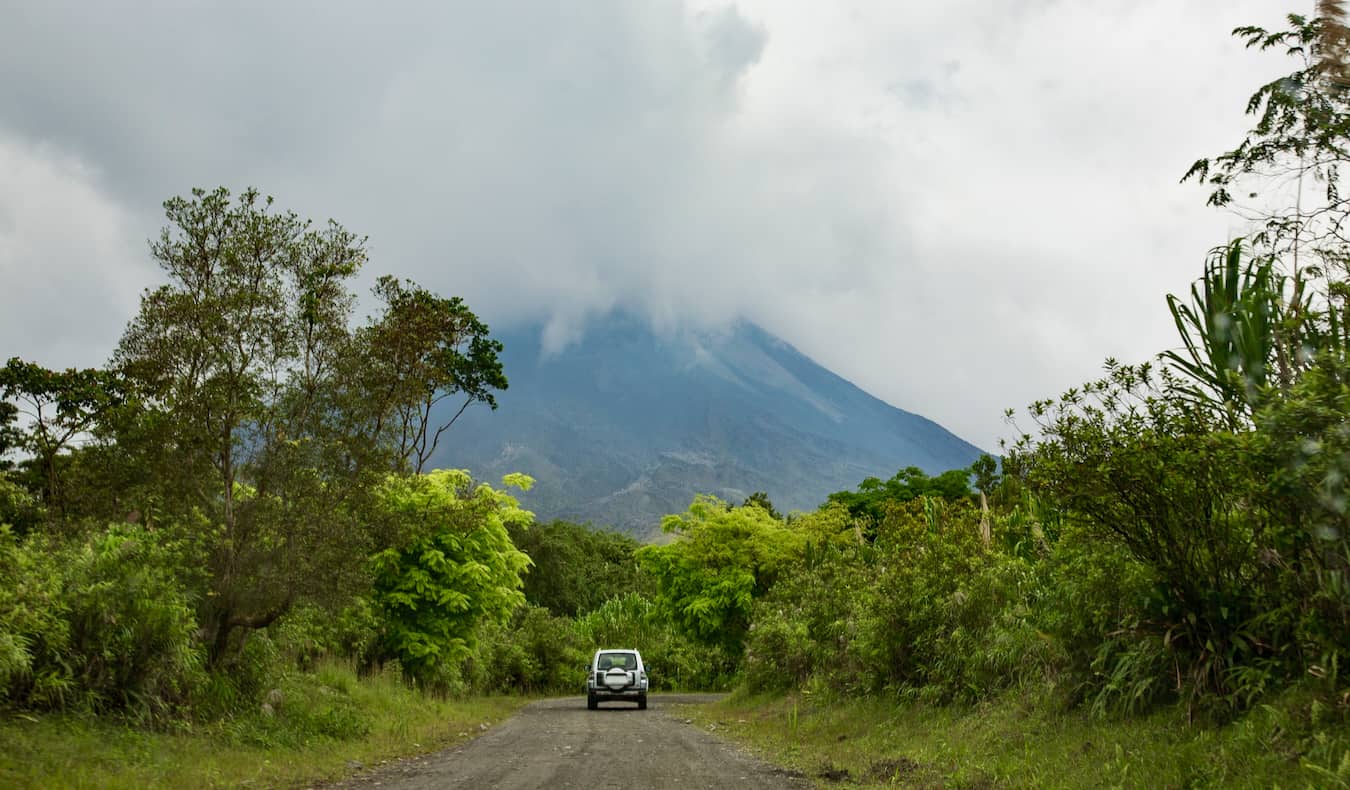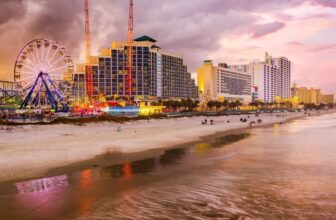
[ad_1]
Posted: 1/25/24 | January 25th, 2024
I love Costa Rica. It was the first place I visited by myself over 15 years ago and the country that set me on my nomadic journey. From its stunning beaches to its lush jungles, this biodiverse nation is popular with backpackers, honeymooners, and expats alike. And while it’s small, there’s a ton to see and do. You could easily spend a month and still barely scratch the surface.
It’s also amazing for road-tripping.
As much as a backpacking bus or hitchhiking adventure might initially sound appealing, the reality is that waiting in the hot sun and then bouncing along bumpy roads in an old bus without shocks or air-conditioning is not for the fainthearted. If you want real freedom to explore, you need a rental car.
To help you plan your trip, here’s everything you need to know about renting a car in Costa Rica.
Picking the Right Rental Car (and Rental Company)
Before you rent a car, read and compare reviews for car rental companies. While the standard big companies are available here, there are lots of local ones too.
Once you have narrowed down the list to a chosen few, ask for quotes for the type of vehicle and travel dates that you require. The quote should include mandatory third-party insurance, taxes, and any other surcharges, like airport tax. Most sites include all this info when getting a quote online.
Whether you are reserving online or directly with an agent, double-check the details of your reservation. Crossing time zones may mean that your rental pickup time or even date is different in Costa Rica than your country of departure. You will need to confirm the time, date, and location of your vehicle’s pickup and drop-off, the vehicle category, transmission, and coverage required.
Points to remember when renting a car in Costa Rica:
- A manual transmission may be cheaper than automatic and more common in Costa Rica but should only be selected if you can drive a stick shift.
- Returning your car at a destination different from where you picked it up will probably incur an additional charge.
- Most rental companies will not guarantee a specific make and model within the rental category.
- Expect to rent for 24-hour periods. Time your pickup and drop-off accordingly.
- Provide your flight number before you arrive, so the company can track your flight.
- If you have an early flight, consider dropping off the vehicle the night before and using a hotel shuttle to the airport.
- Online travel agencies (OTAs) often fail to include all charges, so if you book through one, be sure to check the final price with the car rental company, through which the pricing may be more transparent.
- Most companies now offer an online check-in process to upload documents such as passports and driver’s licenses to cut time at the counter and get on the road faster.
My go-to rental car company in Costa Rica is Vamos. You can click here to get a quote. (You’ll get 5% off just by using that link).
Arriving at the Airport
Both international airports in Costa Rica have car rental company desks within the building; however, the offices (where you’ll get your car) are off-site. They generally have a shuttle service to take clients to their offices, most of which are located within a 10-minute drive of the airport.
Local hustlers might tell you that your company has gone out of business to convince you to go with a different company that will pay them a commission. Look for a sign with your company’s logo and ignore the hustlers.
If your flight is delayed or you miss your connection, contact the company with your new estimated arrival time to avoid having the reservation canceled as a no-show.
When you arrive at the rental office, the agent will fill in any outstanding paperwork that has not been done online and conduct a vehicle inspection with you. Although the agent will note existing damage, you should take photos or video of the car for backup purposes.
Your vehicle may not have a full fuel tank when you pick it up, but the fuel gauge level should be logged on the inspection form. You will need to return the car with the same fuel level. Although you will not be reimbursed for a level higher than the one registered, you will be charged if it is below the starting level.
Returning the Vehicle
Confirm your drop-off location and time when you pick up the vehicle. If you are caught in traffic or are delayed for any reason, contact the rental company to avoid a penalty. Make sure that your fuel gauge is at the right level, or else head to a gas station before you drop it off. The company’s representative will inspect your vehicle with you and then process the deposit reimbursement.
Documents Needed for Renting a Car in Costa Rica
Here’s everything you need to rent a car in Costa Rica:
Driver’s license – You can use your local driver’s license during the rental period as long as it is printed in the Latin alphabet. If your license is in a language that does not use the Latin alphabet (e.g., Mandarin, Arabic), an international driving license is required. Your driver’s license must be valid for the entirety of your stay.
It is important to note that although most tourists will be given a 180-day visa when they enter the country, their driver’s licenses are only valid for 90 days, and they will be required to leave Costa Rica and return to legally drive again.
Credit card – You need a valid credit card in your name to pay the car rental and to place the deposit.
Passport – Your passport should be valid for the duration of your stay. Legally, tourists must carry it with them at all times. The transit police will want to see it and your entry visa if you are pulled over.
A Note on the Minimum and Maximum Driving Age
Each car rental company has policies regarding the age of the drivers it insures. Many do not have a maximum age, but some set a limit of 70-75 years old. The legal age to drive in Costa Rica is 18; however, most companies require that drivers be at least 25. Younger drivers may be able to rent a car for an additional surcharge and insurance costs.
Insurance Coverage
Costa Rica has mandatory third-party insurance for car rentals. It is not possible to obtain this coverage any other way. Check that this cost is included in your rental quote, as it’s often left out, so you may end up paying more than what you initially thought.
A collision damage waiver (CDW) covers losses from damage to your rental car. This is legally required when renting a car in Costa Rica. Most companies offer various tiers of insurance, with various deductibles. Many renters select full coverage for peace of mind, as then any damage that occurs during rental is covered. Some companies offer additional coverage for tires and the windscreen (windshield), as they are not always covered by the CDW.
If your credit card provider has a CDW as a perk, you can waive the in-house CDW. Just note that you will need to bring a letter that explicitly states the amount of coverage, that Costa Rica is included in the areas covered, and the last four digits of the driver’s credit card. A copy of the credit card company’s terms and conditions is not usually sufficient.
One important thing to note is that the rental company may hold a deposit for the rental period, which could be up to $5,000 USD if the renter is using their credit card provider’s CDW. The deposit will be released at the end of the rental period. Make sure you have a credit card that can absorb this deposit.
Driving in Costa Rica
Here are a few things to keep in mind while driving in Costa Rica:
Speed limits – Signs are in kilometers rather than miles, and speed limits are generally lower than you’d expect, with a 90 km/h (55 mph) limit on major highways. Speed limits change with limited warning between areas, so stay alert to signage.
Gas stations – Make sure that you know if your rental vehicle is fueled by gas or diesel. This information should be on the vehicle inspection report if you’ve forgotten. Gas stations are not self-service, so be prepared to ask for the kind of fuel you need as well as the amount.
If you’re renting one of the EVs that are starting to form part of fleets in Costa Rica, then plan your route around the network of charging stations across the country. You can learn more about those here.
Navigation – Use Waze, which is updated in real time by an enthusiastic group of volunteers, so you’re aware of accidents or other situations that may affect your travel time. Google Maps is available but does not always have accurate information. It also tends to underestimate journey times, so you should take that into consideration when planning your itinerary if you plan to use it.
Despite Costa Rica’s official address system, which consists of calles (roads that run north-south) and avenidas (avenues that run west-east), almost all locals give directions using landmarks, and few can provide directions using road or avenue numbers. It’s helpful to know that a block is usually described as 100 meters.
To add to the confusion, a location may use landmarks that no longer exist but were known well enough to remain in living memory. So you may be directed to go 600 meters south of the place “where the big mango tree used to be” or to turn left after “the supermarket that used to be pink.” Thankfully, Waze is a navigation lifesaver, but you might grow to enjoy the quirky tico (Costa Rican) way of finding places!
Parking – Always park in secure parking lots, and do not leave valuables in an unattended vehicle, as break-ins can occur.
In the last few years, there have been cases of the transit police issuing fines and removing license plates from vehicles parked on yellow lines at popular tourist spots like Manuel Antonio. The headache in this situation is that the vehicle cannot be driven without plates and must be towed back to the office, where it remains off the road until the car rental company reclaims the plates from the relevant authority. This is a time-consuming and expensive procedure, so be mindful of where you park!
Additional Rental Considerations
Many car rental companies charge a daily price for equipment or services beyond the basic rental costs. You should take this into account when budgeting your trip. These can include:
Additional drivers – Expect to pay a daily rate for each driver added to your rental agreement after the main driver. (Vamos Rent-A-Car offers additional drivers without extra cost.) It makes sense to have at least one additional driver to share the burden for longer journeys or to take over if the main driver is feeling under the weather.
Roof racks – If you’re traveling with a lot of luggage or surfboards, then renting a roof rack at a daily rate may be a solution to a cramped vehicle interior.
Baby or car seating – If you’re traveling with children, Costa Rican law about seating (see below) is strictly enforced. Either bring your own child seat or rent one at a daily rate from the company.
Costa Rican seating laws for children are based either on age or weight/height:
- Rear-facing baby seat: Required for children less than a year old and under 22 lbs (10 kg)
- Child seat: For those up to 4 years old or less than 40 lbs (18 kg) and under 3’7”
- Booster seat: For those 5 to 12 years old, 40 pounds or more, and still under 4’9”
- Seat belt: For those 4’9” or taller or over the age of 12
Wi-Fi – Stay connected throughout your trip without paying extortionate roaming charges by using a Mi-Fi (mobile Wi-Fi) device from your rental company. It’s usually fast enough to upload your latest vacay pics onto Instagram, connect to your Spotify road-trip playlists, and navigate with Waze, but downloading movies is probably too much to expect. Internet coverage in Costa Rica is wide, but don’t count on it if you are traveling off the beaten track.
Accidents – If you are involved in a traffic accident, check that no one is hurt then move to safety off the road. Do not move the vehicle. Call the transit police and your insurance company. You should also call your car rental provider to assess if the car can be driven, if a mechanic is required onsite or if the car needs to be exchanged and towed. The vehicle can be moved once the transit police give permission.
Crossing the Border – Rental vehicles cannot be taken to neighboring countries (Nicaragua or Panama) due to insurance restrictions. If you want to visit those places, you can arrange to drop off your rental vehicle at the border and reserve a car to be delivered once you’ve crossed it.
11 Driving Tips for Costa Rica

1. Keep a close eye on speed limit signs, as this can change quickly within a short distance.
2. You’re renting a car, not a boat, so resist the temptation to drive through rivers (even if the locals are doing so). Insurance policies are voided if the vehicle is driven through any body of water. And the electronic components of modern vehicles are likely to experience expensive damage in water.
3. On a similar note, it is illegal to park on the beach. This is to protect wildlife, such as turtles. Even if locals are doing it, find a secure parking lot instead.
4. Drivers in the other lane may flash their lights as they are coming toward you. This is usually a warning that there are transit police ahead or that there’s an upcoming obstacle.
5. Speed bumps may be big and could be unmarked. Stay vigilant.
6. Bridges may be one lane, so you need to look for signage that indicates which direction has priority.
7. If driving a manual-transmission vehicle, change gears when driving downhill, and don’t ride the brakes or else the pads could overheat.
8. Use caution while driving at night. Roads are often poorly lit, and cyclists or pedestrians may use the road edge in places where there’s no sidewalk. Plan to arrive at your destination by sunset or around 5:30pm. Keep your eyes peeled for sloths or other wildlife crossing the road.
9. If you’re traveling outside of the Central Valley or the most visited tourist spots like Jaco, rent an SUV for the higher clearance that the vehicle offers. For more rural destinations, a 4×4 may be required, especially in the rainy season. Feel free to ask your car rental provider for advice on the best vehicle for your itinerary.
10. Flat tires are not usually covered by in-house or credit card policies. If you get a flat tire, a local garage can usually fix it for less than $20 USD.
11. If you are pulled over by the transit police, you should present your driver’s license, passport, and the paperwork provided by the car rental company. Traffic tickets can be issued by officials, but the payment can only be made in a bank or via your car rental company. Should a police officer ask you for cash, call the police directly or your car rental company for assistance. Do not pay any bribes.
Costa Rica is a beautiful country and one of my favorite destinations in Central America. To ensure you make the most of your visit and get off the beaten path, rent a car. You’ll have more freedom and flexibility, and be able to explore beyond the standard tourist sites. I can’t recommend it enough!
Book Your Trip to Costa Rica: Logistical Tips and Tricks
Book Your Flight
Use Skyscanner to find a cheap flight. They are my favorite search engine because they search websites and airlines around the globe so you always know no stone is left unturned!
Book Your Accommodation
You can book your hostel with Hostelworld as they have the biggest inventory and best deals. If you want to stay somewhere other than a hostel, use Booking.com as they consistently return the cheapest rates for guesthouses and cheap hotels. My favorite places to stay are:
Don’t Forget Travel Insurance
Travel insurance will protect you against illness, injury, theft, and cancellations. It’s comprehensive protection in case anything goes wrong. I never go on a trip without it as I’ve had to use it many times in the past. My favorite companies that offer the best service and value are:
Looking for the Best Companies to Save Money With?
Check out my resource page for the best companies to use when you travel. I list all the ones I use to save money when I’m on the road. They will save you money when you travel too.
Want More Information on Costa Rica?
Be sure to visit our robust destination guide on Costa Rica for even more planning tips!
[ad_2]






